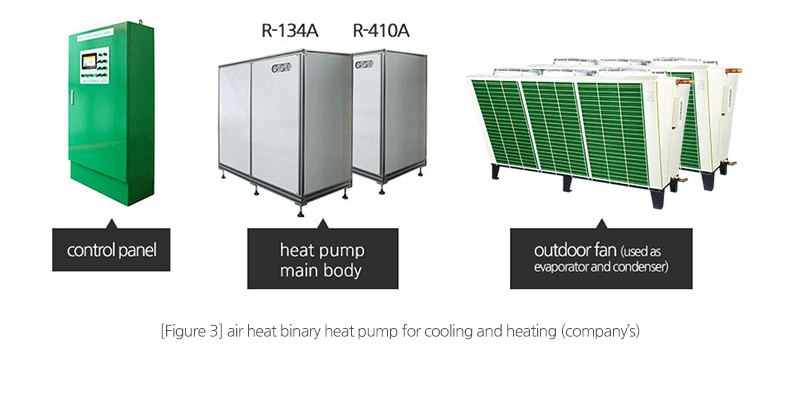Heat pump system
 > Technical data > Heat pump system
> Technical data > Heat pump system
- What is heat pump?
Overview of heat pump - The heat pump is a mechanical device that absorbs heat from low temperature heat source and transfers to the high temperature heat source instead of producing heat autonomously. It is called a heat pump because it is similar to pumping up the water from low water level to high water level. The heat pump is classified into compression, chemical, absorption, and adhesion methods according to the principle of absorbing and radiating heat, and the method commonly used for commercial use is the compression heat pump. In a sense of pulling up the low temperature and low density heat energy to the state of usable high temperature and high density heat energy, it is a mechanical device that transfers low to high temperature or the otherwise and uses in cooling, heating or in hot water. As a mechanical device that absorbs heat from low temperature heat source and transfers to high temperature water source, it is a saving type of device that provides heat energy of 3 to 4 times than the electric power needed.
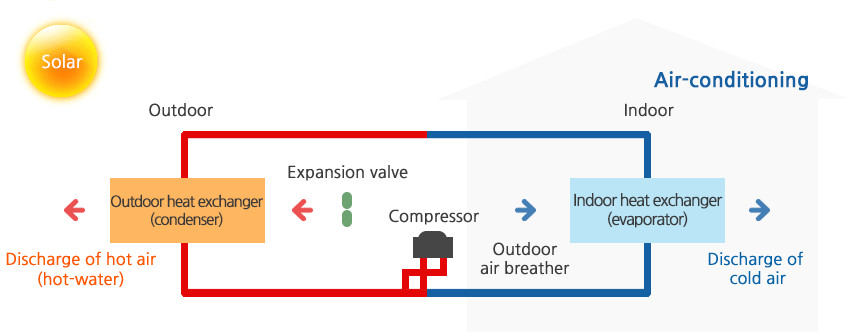
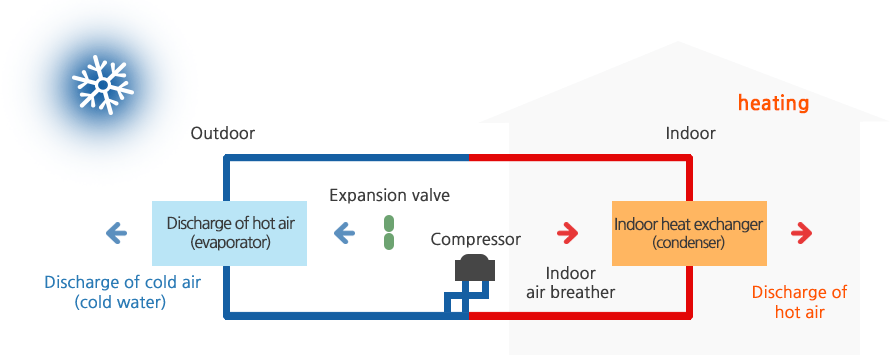
- Principle of heat pump
principle -
A refrigerant transferring heat is placed inside the heat pump.
The refrigerant evaporates (fluid → gas) inside the evaporator as it absorbs heat
from outside and becomes gas of low temperature and low pressure,
and it is absorbed to the compressor.
As the refrigerant is absorbed inside the compressor, it is delivered to the condenser in the state of high temperature and high pressure and as it releases heat (using warm air and water), it liquefies.
The high-pressured liquefied refrigerant is decompressed inside the expanding valve and the refrigerant in the state of low temperature and low pressure enters into the evaporator.
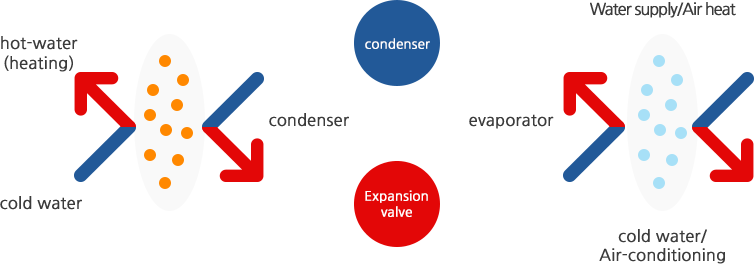
- Air heat heat pump
hit pump - It is an advanced technology system that cooling, heating and hot water production are possible with one unit of equipment by absorbing necessary amount of heat from atmosphere when heating, and by emitting internal heat to atmosphere when cooling. For instance, in order to obtain 100% energy 25% of electricity, it is inserted to a boiler and 60~80% energy is absorbed from atmosphere; thus, power ratio can be reduced drastically.
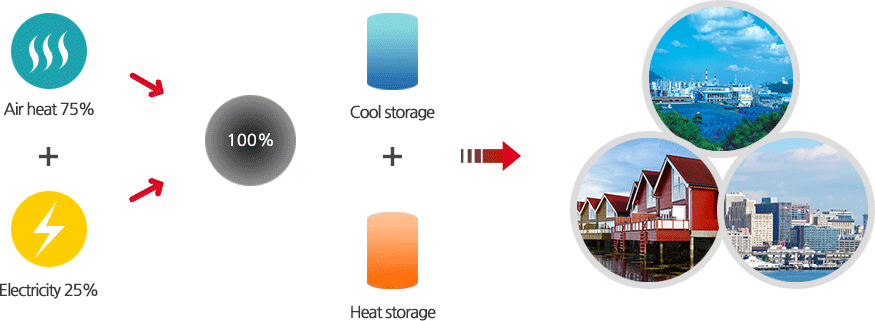
- Terminology
arrangement of terms -
- ① Refrigerant [冷媒] : A medium that can draw high temperature object from low temperature object such as a refrigerator. There are Freon, ammonia, sulfur dioxide and methyl chloride. (R22, R134a)
- ② Compressor : A device that narrows down the distance between molecules by increasing the temperature and enables condensation and liquefaction even in high temperatures by absorbing and compressing the refrigerant gasified after freezing in the evaporator and by pulling up the pressure. The kinds of compressor are scroll compressor, reciprocating compressor, screw compressor, centrifugal compressor, etc.
- ③ Evaporator : It is equipment that freezes with heat absorption due to evaporation by flowing in the liquid refrigerant decompressed to low temperature and low pressure, passing through the expanding valve and by exchanging heat with surrounding space or a matter being cooled.
- ④ Condensation : It refers to vapor or other gases and steam being liquefied as these are heated, and the amount of heat received is called as condensed latent heat of a matter.
- ⑤ Plat type evaporator : It is equipment exchanging heat by putting 2 sheets of aluminum or stainless plate and making paths for refrigerant and water between the plates.
- ⑥ Receiver tank : A container that temporarily stores the liquefied refrigerant in the state of high pressure condensed in the condenser.
- ⑦ Expansion valve : It is a valve that decompresses the pressure that can evaporate the liquefied refrigerant of high temperature and high pressure that is decompressed and liquefied in the condenser. Also, it adjusts and provides moderate amount of refrigerant that can absorb enough amount of heat in the evaporator.
- ⑧ Coefficient of performance : It is a coefficient marking the fineness or defectiveness of boiler efficiency that higher the coefficient, better the efficiency.
- Principle of cooling cycle (air heat heat pump)
principle of refrigerating cycle -
- Comparison of single cycle and binary cooling cycle of heat pump
-
- ① Ordinary heat pump is composed of single cycle as shown in [figure 1], and producing hot water of high temperature for heating with single-cycle heat pump is difficult, in particular, the heating performance sharply falls when the outdoor temperature goes down during winter.
- ② Binary cooling cycle heat pump is composed of 2 cycles as shown in [figure 2], and an evaporator of high temperature cooling device and a condenser of low temperature cooling device (these 2 heat exchangers are called as cascade heat exchanger) are installed to enhance the energy efficiency, consistently maintaining and providing hot water and hot temperature even when outdoor temperature during winter goes down. During the summer season, this heat pump system produces cold water to reduce the peak-load.
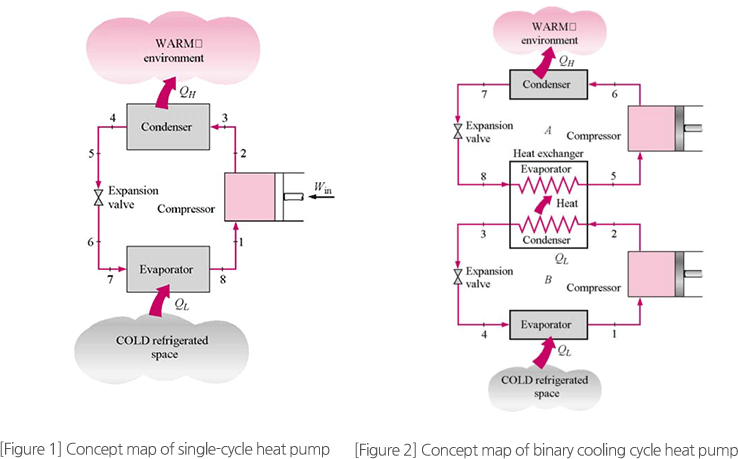
- Comparison of binary cooling cycle (air heat heat pump)
principle of refrigerating cycle -
- 1. Binary cooling cycle heat pump system of the company
-
- ① As a system for both highly efficient cooling and heating, it can produce cold and hot water simultaneously.
- ② Patent "Double pipe heat exchanger" (Heat exchange of high temperature R-134A and low temperature R-410A cycle is possible when exchanging heat of outdoor fan)
- ③ High temperature cycle heat exchanger is operated with the defroster when heating, and the condenser when cooling, thus only the product of the company has 100% cooling capacity among the products applied with binary cooling cycle. (Strength)
- ④ Low temperature cycle heat exchanger is operated with an evaporator when heating. Regarding the cooling system, the production cost of cold water is 'ZERO' when cooling in a place with use of hot water. (Strength)
- ⑤ For workplaces with the use of hot water in relation to the cooling system, 0% production cost of cold water when cooling
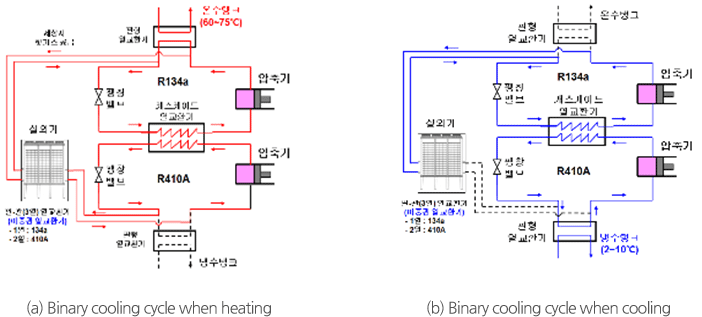
- 2. Other company’s binary cooling cycle heat pump system
-
- ① Emphasis on the exclusiveness for heating ad production of high temperature water
- ② Composed of reverse cycle without any separate auxiliary heat source when operating a defroster
- ③ When cooling, only low temperature cycle R-410A is used, thus it has only 50% of cooling capacity.
- ④ Requires twice as much of facility to have cooling capacity same as our company. (Weakness)
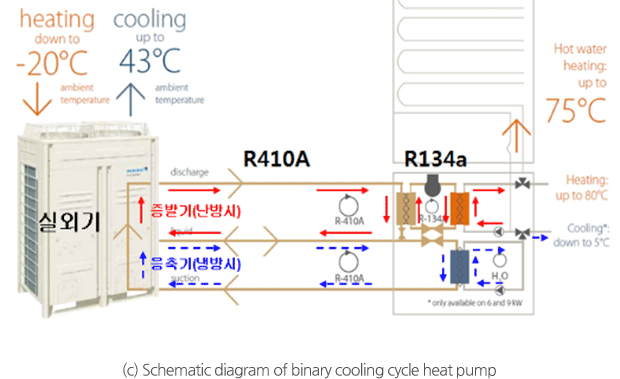
- Competitiveness of technology possessed by the company (air heat heat pump)
technology competitiveness -
- 1. Securing technical competitiveness
-
- ① Securing diagnosis and designing technology of energy saving system
- ② Securing production technology of binary cooling cycle
- Defrosting technology using hot gas
- Technology controlling compression ratio of low temperature and high temperature of binary cooling cycle
- Technology controlling compression ratio of low temperature and high temperature of binary cooling cycle
- ③ Securing technology for site installation and construction
- 2. Patent application and registration
-
- 2010.02.01 : Registration of expertise geothermal energy business for Sinwoo Integral Energy's New Renewable Energy
- 2011.01.12 : Patent application for open & enclosed cooling/heater and cold/hot water production system using geothermal source for anti-scaling use
- 2011.01.12 : Patent application for internal heat exchanger for hot water tank and temperature maintenance system using the heat exchanger
- 2011.10.13 : Registration of invention patent for wastewater circulation auto cleaning evaporator device of wastewater collection type heat pump
- 2011.10.13 : Registration of invention patent for uncovered pipe evaporator device for wastewater collection type heat pump
- 2012.03.14 : Registration of invention patent for hot water heat pump system
- 2012.06.08 : Registration of refrigerator production and specific equipment production
- 2012.07.13 : Conformation as a venture company by Korea Technology Finance Corporation
- 2013.03.26 : Registration of invention patent for binary heat pump device
- 2013.12.06 : Application of international patent (China) and invention patent for binary heat pump
- 3. Application of remote control management system
-
- ① Smartphone remote control is possible so you can monitor and check abnormal conditions in real time using smart phone at anytime anywhere.
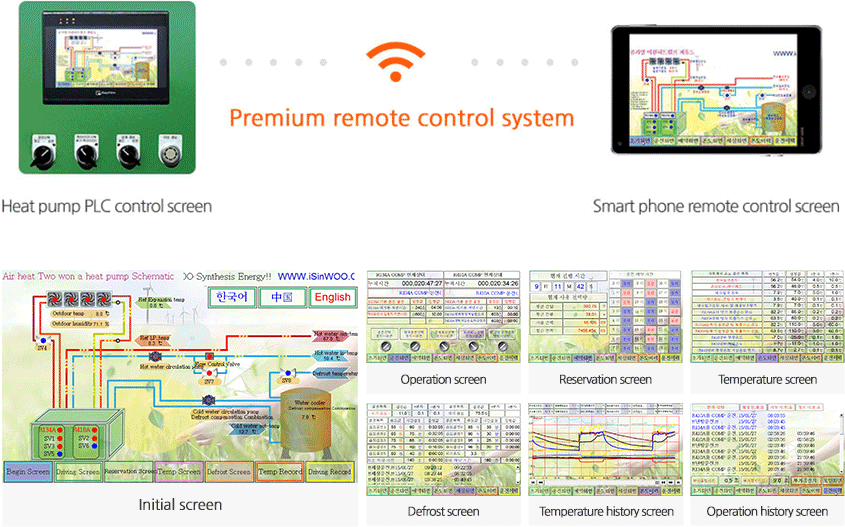
- 4. Development and mass production of "World's first" double heat exchanger for evaporator and condenser with invention patent for new technology no. 10-1262927
-
- 1) "Double pipe heat exchanger" is constructed on the heat exchanger of the air enabling high temperature and low temperature cycle to exchange heat that when heating high temperature R-134A, the defroster fully operates while when cooling, the condenser fully operates
- ① Binary refrigeration cycle heat pump for cooling and heating produces large capacity from 30HP up to 150 HP
- ② Heating performance low temperature (-38℃) heating COP: feasible over 2.29
- ③ Temperature of out flowing water for low temperature (-38℃) heating: produces from 65℃ ~ 70℃
- ④ When cooling, cold water temperature is available up to -5℃ that thermal storage efficiency (contrast with existing single stage heat pump): above 20%
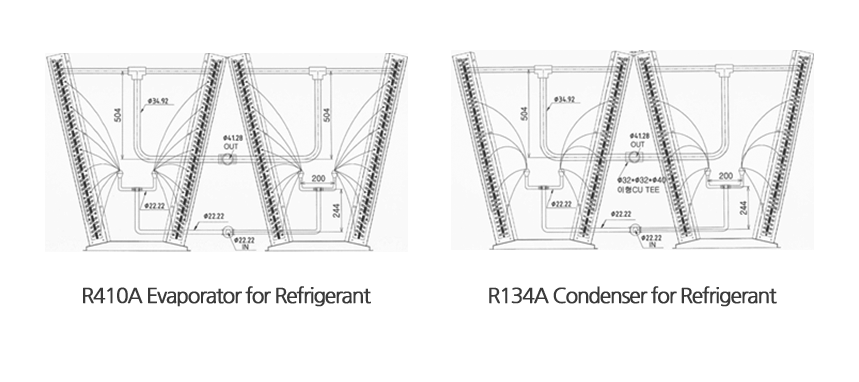
- air heat binary heat pump for cooling and heating
introduce goods - It is an energy saving system that applies binary refrigeration cycle (cascade compression system) which uses 2 units of screw-type compressors for above 80HP, uses the heat source of the atmosphere that it is limit-free, and it is suitable to places using high temperature water because the degradation at 15 degrees below zero temperature is slight.
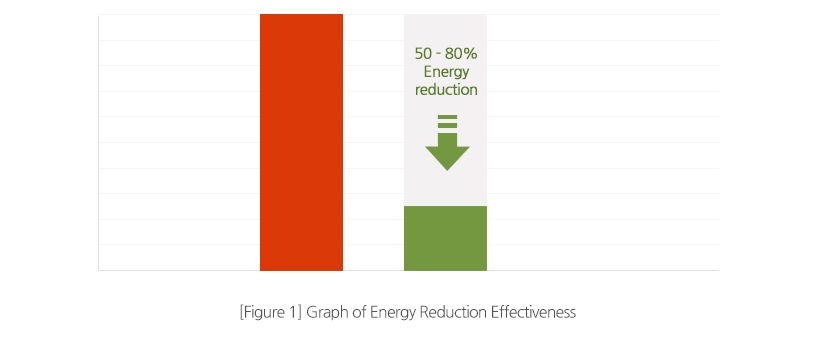
- Product features
-
-
① Sole producer of large capacity air heat binary heat pump in Korea (30HP//90HP/150HP)
- Invention patent of technology no. 10-1262927
- "World's first" application of double heat exchanger for evaporator and condenser
- ② Excellent economic feasibility with production of cooling/heating and cold/hot water
- ③ Application of smart phone remote control management system
- ④ PLC auto control system convenient to use
- ⑤ 9-phrase auto defrosting control according to temperature/humidity
- ⑥ Separation installation of outdoor fan reduces noise and prevents risk of freeze and burst during winter season
-
① Sole producer of large capacity air heat binary heat pump in Korea (30HP//90HP/150HP)
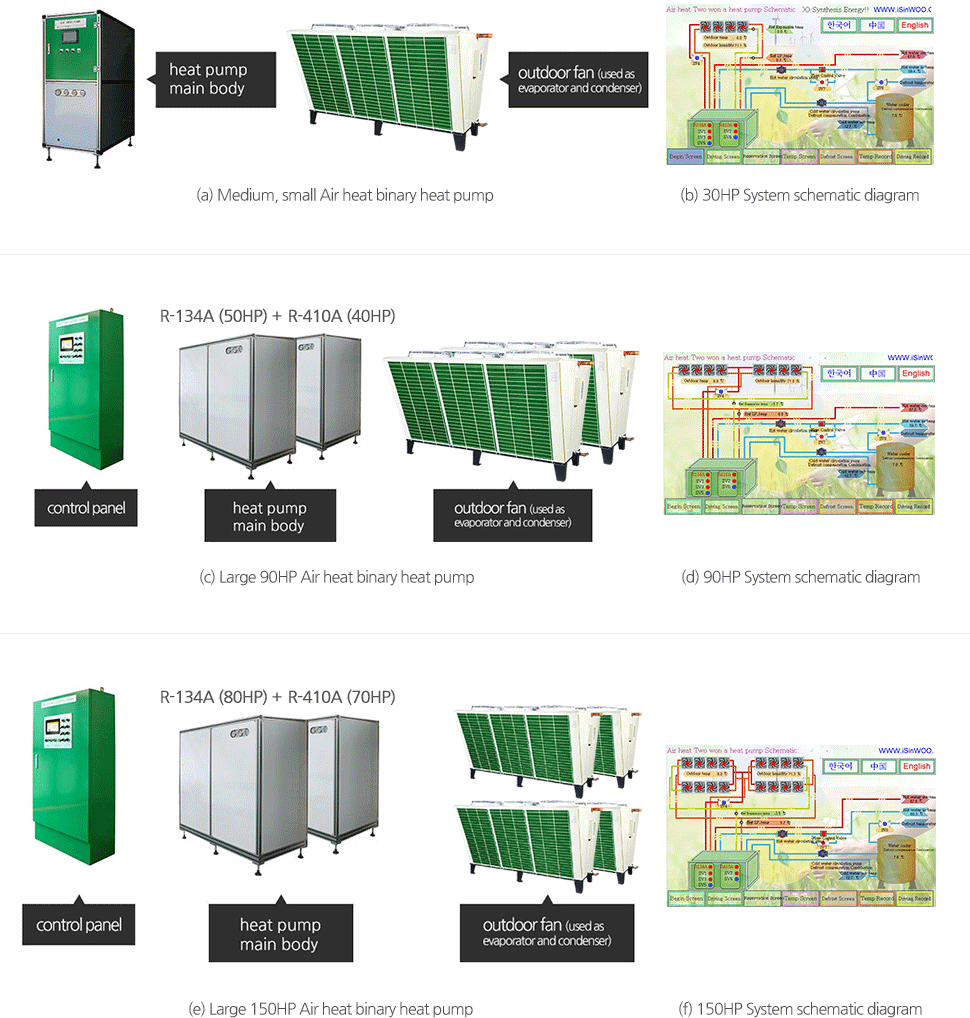
- Comparison of high-capacity products
(Air heat binary heat pump for cooling and heating VS Other company
comparison goods -
- 1. Absorptive chiller and heater (other company)
-
- ① It is installed focusing on cooling and heating in high-rise and large buildings, but it uses fossil gas (aside from gas) that it is restricted by different environmental regulations because it has depletion problem on resources and it causes air pollution.
- ② 50~70% excessive expense takes place for management expense compared to the product of our company.
- 2. Chiller for cooling (Other company)
-
- ① It is installed focusing on the cooling and heating of high-rise and large buildings, but it has no heating function that when there is a demand for heating, a separate heating facility should be additionally installed that additional expense takes place.
- ② In case of adding heating facility, fossil fuel is used, thus causes pollution.

- 3. Air heat binary heat pump for cooling and heating (당사)
-
- ① New renewable system using air heat source as an alternative energy technology for international climate change and environment regulation
- ② The system can produce high-efficient heating and hot water in the outdoor temperature of 15℃ below zero temperature during winter and that can produce both cold and hot water at the same time when cooling during summer. The production cost of hot water is 'ZERO' when heating if there is a use of hot water.
- 1) Strengths in comparison with absorptive chiller and heater
-
- ① Uses power energy instead of fossil fuel that it is free from environmental pollution
- ② Can reduce energy by 50 ~ 70%
- 2) Strengths in comparison with chiller for cooling
-
- ① 'Zero' production cost of hot water when cooling if there is a use of hot wat
- ② A chiller does not have heating capacities, but our company’s product can both cool and heat with one unit of heat pump that you can reduce the installation cost.
- ③ Can reduce energy cost by 50~70%
